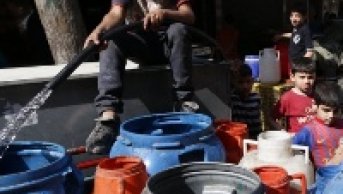Iran Speeds up Dam Construction to Deal with Water Shortage

Iran, which is subjected to the Middle East’s semi-arid climate, has a large geography with a surface area of 1.7 million square kilometers.
It is located in one of the most arid regions of the world and its average annual precipitation is 252 millimeters. This figure is just a fourth of the world’s average precipitation. In the current climatic conditions, 179 millimeters -or 71 percent- of this precipitation evaporates. The average evaporation occurring in Iran varies between 1,500-2,000 millimeters. This figure is a third of the world’s average. While this number is 2,000 millimeters/year in the northern mountainous region of the country, in the desert area it is 20 millimeters/year. Two-thirds of Iran receives precipitation below the average amount.
Water resources in Iran are mostly used for irrigation purposes, as is the case around the world. About 92.8 percent, or 83.5 billion cubic meters, of the water consumed is used for irrigation. Around 50 percent of the water used in the area of agriculture is obtained from surface water, and about 50 percent is obtained from underground waters.
In areas where water resources are scarce like Iran, it is seen that apart from water shortage, another problem is that water is not used efficiently due to poor management of water resources. Comprehensive research on irrigation indicates that it is necessary for irrigation methods to be changed in order to reduce water loss and water resources to be used efficiently and for modern irrigation techniques like drip irrigation and sprinkling to be developed.
In recent years, Iran has been one of the leading countries in terms of the construction of dams. In Iran, which is the top country in the region and the third in the world in the sector of dam construction, dam construction started in the 1950s. Before the Islamic Revolution of 1979, only 14 large dams had been constructed through the investments of foreign banks and companies. The new political system, established after the 1988 Iranian-Iraqi war, also affected the management of water resources, and the construction of dams has gathered speed. Today, Iran is able to construct its dams without foreign capital. The dams in Iran are meant to help use and control reservoirs for the long term. The dams in Iran are firstly constructed for the purposes of providing drinking water, irrigation, producing hydroelectricity and as storage during the transfer of water between basins. Until now, approximately 541 dams, both large and small, have been constructed in Iran. According to the International Commission on Large Dams (ICOLD), this number is 501. In 2007, the construction of 88 dams also began. This figure grew to 135 dams in 2011 and 546 more dams are planned to be constructed. The total amount of water stored in dams in Iran to date is 52 billion cubic meters.
This week, the inauguration of 15 dams took place in Iran. The total water capacity of these dams is 6 billion cubic meters. With this, the total capacity of dams in Iran will be 61 billion cubic meters, and this is approximately double the annual flow rate of the Euphrates. Director of the Iranian Water Resources Management Company Mohammad Hajrasouliha has expressed in statements that 75-80 percent of surface water flows to the dams and that 36 billion Iranian rials have been allocated for the construction of dams. In addition, it has also been indicated that 135 dams are still in the process of being constructed.
For many years, Iran has attempted to resolve its water shortage problem, which is experienced in specific areas of the country due to unequal distribution of water resources and demand, by transferring water between basins. It is predicted that a rapid increase in population, population movement intensifying in cities, food issues, a fall in precipitation and droughts will make it difficult for Iran to meet its demand for water in the coming period. By applying modern irrigation techniques, developing projects on water transfer between basins, building dams and reservoirs to store water and taking steps towards cooperating with its eastern neighbors, Iran is attempting to find a solution to resolve its problems of water amount and quality.
Furthermore, the water shortage envisaged for the next 10 years has especially started showing itself in Iran with the arid periods experienced in the last three years. According to statements by Alborz province’s Water Resources Management Unit, as mentioned above, an increase in population, insufficient investment and poor management create problems in the sustainable management of water resources. Based on the calculations of Iran, which has experienced periods of drought over and over again in recent years, the amount of water per person will be 1,300 cubic meters in 2020. Moreover, dust storms carried either from Iraq or from other neighboring countries which also contain salt create another problem in that damages the quality of water and soil.





